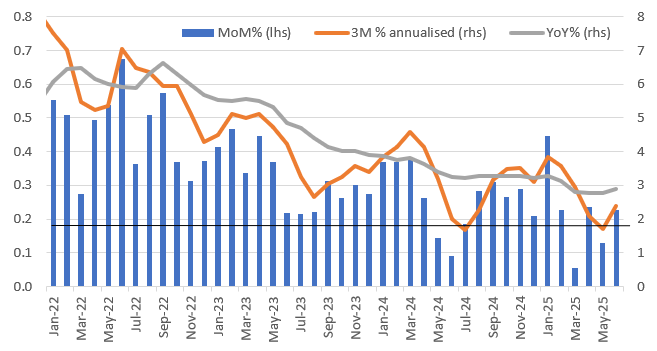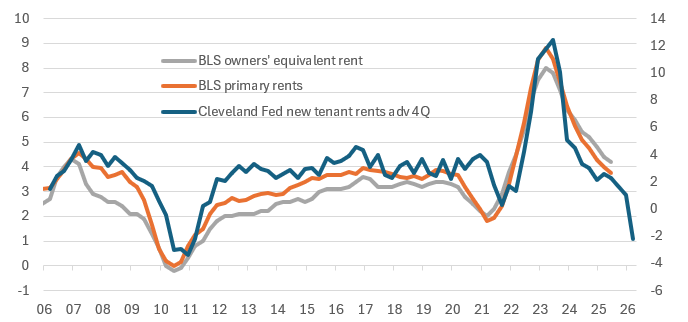Five things to watch in markets in the week ahead
A slightly softer-than-expected June core inflation reading keeps alive the chances of a September Federal Reserve interest rate cut, but the risk is that we get less benign prints for July and August. That means we will need to see clear evidence of softer jobs figures to trigger Fed action before December
0.228% - MoM core inflation - Lower than expected
Some Evidence of Early Tariff Impacts, But Weak Shelter and Falling Car Prices Offset
The June consumer price inflation report shows a 0.3% month-on-month reading for headline inflation (0.287% to three decimal places) and a 0.2% MoM outcome for core (0.228%) versus the consensus forecast of 0.3% for both. The details show that there was some scattered evidence of early tariff impacts on some goods components – mainly fresh fruit & vegetables, household appliance, toys, clothing and sporting goods, but this was offset to a large extent by softness in the all-important shelter component, which has an approximately 40% weighting within the core CPI basket. It rose only 0.2% MoM while new vehicle prices fell 0.3% and used cars fell 0.7% despite fears that this could be a source of inflation in coming months given substantial tariffs being applied to the sector. Airline fares fell yet again, but only by 0.1% MoM this time.
Core CPI MoM%, 3M Annualised and YoY%

Source: Macrobond, ING
More Ammunition for the President, but That Will Change
This sub-consensus core CPI figure may give President Trump an excuse to launch another salvo at Jerome Powell, but we always suspected it would be three months from April/May before the tariffs show up in force. That means the July, August and September CPI reports are where we will see the potential for 0.4%+ MoM prints. President Trump has been pushing the Fed to cut rates by 200bp to 300bp immediately, and two of his appointees to the FOMC from his first presidential term (Chris Waller and Michelle Bowman) suggested they could vote in favour of a cut as soon as the July FOMC meeting. However, the rest of the committee feels they have time to wait, especially in light of the recent firmer-than-expected June jobs report.
Fed Doesn’t Want To Get It Wrong Again
The Fed was stung by criticism after suggesting the post-pandemic supply shock price hikes would be “transitory”, only for inflation to hit 9% in 2022. We suspect a majority of FOMC members will want to ensure that tariffs are a one-off price change rather than something that leads to greater permanence in inflation. We doubt they will have enough evidence to be certain of that by the September FOMC meeting, so we would need to see some significant weakness in jobs to trigger a rate hike at that point. That suggests the president’s frustrations with Jerome Powell will intensify, with him set to seek a more dovish replacement for when Powell’s term as Fed Chair ends early next year.
Housing Could Become a Major Source of Disinflation Late 2025/Early2026

Source: Macrobond, ING
Fed to Wait, but Cut by 50bp in December
Nonetheless, interest rate cuts will eventually come. The cooler growth environment with a softer jobs narrative and weakening wage pressures will help ensure that inflation is indeed temporary. Moreover, the shifting dynamics of the housing market will mean housing costs, which have been a major driver of inflation in recent years, will increasingly become a source of disinflationary pressure as hinted at in the chart above using the Cleveland Fed’s new tenant rents series. With the risk that unemployment does start to climb later in the year in response to intensifying growth headwinds, we believe the Fed will be much more comfortable with cutting interest rates from the December FOMC meeting, kicking off with a 50bp move.
Disclaimer: This publication has been prepared by ING solely for information purposes irrespective of a particular user’s means, financial situation or investment objectives. The information does not constitute investment recommendation, and nor is it investment, legal or tax advice or an offer or solicitation to purchase or sell any financial instrument. Read more
